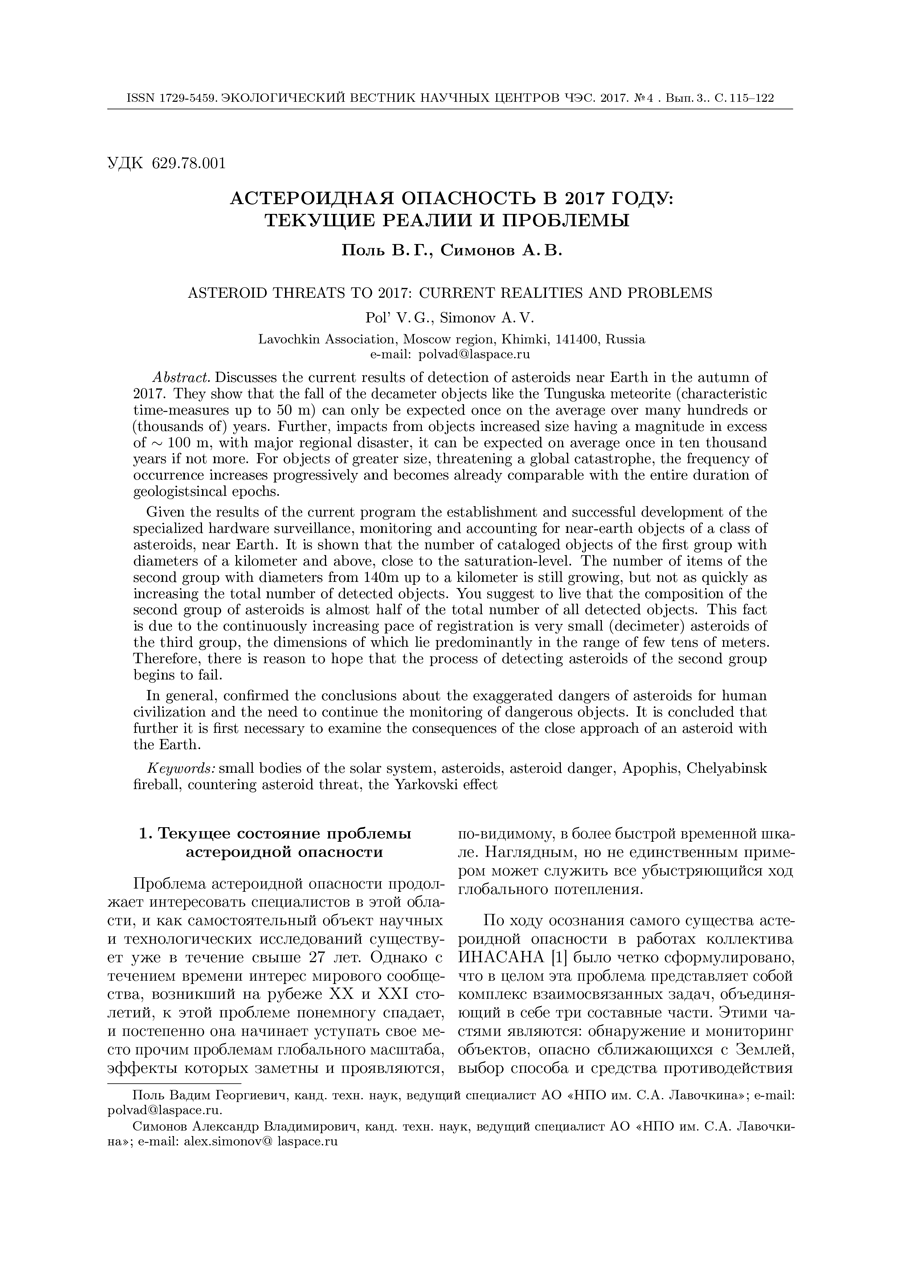Asteroid threats to 2017: current realities and problems
UDC
629.78.001Abstract
Discusses the current results of detection of asteroids near Earth in the autumn of 2017. They show that the fall of the decameter objects like the Tunguska meteorite (characteristic time-measures up to 50 m) can only be expected once on the average over many hundreds or (thousands of) years. Further, impacts from objects increased size having a magnitude in excess of $\sim 100$ m, with major regional disaster, it can be expected on average once in ten thousand years if not more. For objects of greater size, threatening a global catastrophe, the frequency of occurrence increases progressively and becomes already comparable with the entire duration of geologistsincal epochs. Given the results of the current program the establishment and successful development of the specialized hardware surveillance, monitoring and accounting for near-earth objects of a class of asteroids, near Earth. It is shown that the number of cataloged objects of the first group with diameters of a kilometer and above, close to the saturation-level. The number of items of the second group with diameters from 140m up to a kilometer is still growing, but not as quickly as increasing the total number of detected objects. You suggest to live that the composition of the second group of asteroids is almost half of the total number of all detected objects. This fact is due to the continuously increasing pace of registration is very small (decimeter) asteroids of the third group, the dimensions of which lie predominantly in the range of few tens of meters. Therefore, there is reason to hope that the process of detecting asteroids of the second group begins to fail. In general, confirmed the conclusions about the exaggerated dangers of asteroids for human civilization and the need to continue the monitoring of dangerous objects. It is concluded that further it is first necessary to examine the consequences of the close approach of an asteroid with the Earth.
Keywords:
small bodies of the solar system, asteroids, asteroid danger, Apophis, Chelyabinsk fireball, countering asteroid threat, Yarkovski effectReferences
- Shustova B.M., Rykhlovoy L.V. (eds.) Asteroidnaya opasnost': vchera, segodnya, zavtra. Moscow, Fizmatlit Pub., 2010, 384 p. (In Russian)
- Harris A.W. Esimating the NEO population and impact risk: past,present and future. In: Proc. 1-st IAA Planetary Defense Conference for Protecting Earth from Asteroids, Granada, Spain, 27-30 Apr., 2009.
- Near-Earth Asteroid Discovery Statistics. Available at: http://cneos.jpl.nasa.gov (access date 30.09.2017).
- Terentjeva A., Bakanas E.S. Meteor stream of the large Chelyabinsk fireball. J. Int. Meteor Organization (WGN), 2013, vol. 41, no. 2, p. 39.
- Sokolov L.L., Bashakov A.A., Pit'ev N.P. Osobennosti dvizheniya asteroida 99942 Apophis [Features of the motion of the asteroid 99942 Apophis]. Astronomicheskiy vestnik [Astronomical Bull.], 2008, no. 1, p. 20. (In Russian)
- Chesley S.R. Potential impact detection for near-Earth asteroids, the case of 99942 Apophis (2004 MH4). In: Proc. IAU Symposium 29$^\text{th}$, 2005. Cambridge University Press, Cambridge, 2006, pp. 215-228.
Downloads
Issue
Pages
Submitted
Published
How to Cite
Copyright (c) 2017 Pol' V.G., Simonov A.V.

This work is licensed under a Creative Commons Attribution 4.0 International License.




